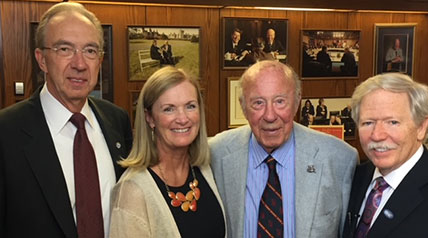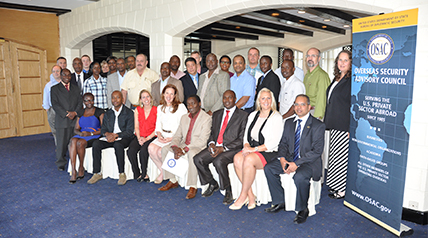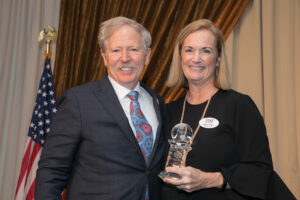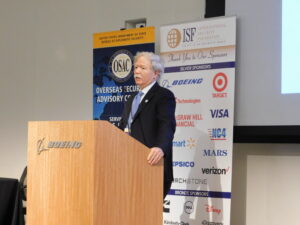5 Questions for Jim Snyder
In 2011, Jim Snyder, then OSAC Co-Chair, gathered a small group of private-sector security leaders and U.S. Department of State attorneys to focus on a big idea: creating the International Security Foundation (ISF).
Their founding vision and Jim’s service as the ISF’s first Executive Director from 2016 to 2017 created an impressive decade of achievement and support for OSAC, and now through the ISF’s grants program, U.S. security nonprofits.
We asked Jim, in his own words, to share his unique perspective on why the ISF was needed and on its impact ten years later.
What inspired you and other OSAC private sector leaders to create the ISF?
George Shultz, the visionary Secretary of State who created the Overseas Security Advisory Council (OSAC), wanted the federal government and private-sector organizations to work together to prevent terrorist incidents, like the October 1983 bombing of the Marine Corps barracks in Beirut that killed more than 300 Marines and civilians.
Secretary Shultz, who’d been a Marine captain and president of the Bechtel construction company, couldn’t find a governmental structure that matched his vision of American public- and private-sector organizations working together for their mutual protection overseas.
He settled for the imperfect solution of creating OSAC as an advisory committee to the Secretary of State under the authority of the Federal Advisory Committee Act (FACA). The FACA proved to be a problem because State Department funding was permitted only for meetings of the 34-member OSAC Council. Other OSAC activities including OSAC regional committee meetings, OSAC sector committee meetings, topical symposiums and, perhaps, most importantly, Country Chapter meetings, were not eligible to receive government funding.

Jim (far right) in 2015 with Sec. George Shultz, ISF Board member Ron Iden and Peggy O’Neill, ISF Executive Director.
To stage most “non-Council” OSAC engagements, it was necessary to first secure a private-sector sponsor. Instead of focusing on program development, OSAC Program Office personnel and Regional Security Officers (RSOs) spent most of their time trying to find sponsors willing to underwrite the cost of proposed OSAC events.
Around 2010, it had become clear to many on the OSAC Council that OSAC was at a crossroads and that fundamental change would be necessary if OSAC were to meaningfully advance Secretary Shultz’s vision.
To address these and other shortcomings, Brad Brekke, CSO for Target, John McClurg, CSO for Dell and Jim Hutton, CSO for Proctor & Gamble agreed to serve as members of the International Security Foundation’s (ISF) initial Board of Directors.
On April 11, 2011, the Secretary of State for the State of Texas certified that the Certificate of Formation establishing the ISF as a Domestic Nonprofit Corporation had “been found to conform to the applicable provisions of law.”
The ISF was officially open for business.
What was the first ISF-funded OSAC event?
In September of 2013, Islamic extremists attacked the Westgate Mall, an upscale shopping center in Nairobi, Kenya that was very popular among western expats. The attack, which left more than 60 dead and 200 wounded, sent a shockwave through the community of American expats in Africa.
To address their concerns, Marion Cotter, the RSO in Nairobi, immediately began planning a comprehensive briefing at the Embassy that would provide detailed information concerning the attack and the attackers and an overview of the jihadist threat in Africa, which would be presented by an OSAC Research and Information Support Center analyst flying from Washington.

The first-ever ISF-funded OSAC event in Nairobi.
Through OSAC focus groups, I’d learned that it was common for RSOs to use personal funds to pay for refreshments at Country Council meetings. So, it came as no surprise that when she was informed that Embassy representational funds would not be available for the briefing, Marion, like her RSO colleagues elsewhere, decided to use her own money to pay for snacks and beverages.
Fortunately, donations to the ISF had reached a level that the ISF could cover the cost of the cookies and soft drinks to be served at the Nairobi briefing as well as cover the cost of refreshments at Country Council meetings elsewhere.
Marion was the last government employee to ever face the distasteful prospect of having to plead with an OSAC member organization to sponsor an OSAC event or pay for one out of her own pocket.
Since the Nairobi Country Council meeting in 2013, the ISF has funded more than 250 OSAC events, has facilitated the launch of three Regional OSAC Councils, has helped OSAC reinvigorate its sector groups, and has otherwise made it possible for OSAC to be more closely aligned with George Shultz’s vision.
What was the most difficult part of establishing the ISF?
People look at OSAC today and see the ISF as an integral part of a vibrant, progressive public-private partnership that has the resources to successfully take on a diverse set of new and important initiatives like the Women in Security program.
Because the ISF-OSAC collaboration has worked so well for a decade and has been such an important factor in keeping Americans safe overseas, people sometimes lose sight of the fact that, at the time of its founding, the ISF was an extremely radical concept. For some, the ISF even represented an existential threat to OSAC’s very existence.
The most difficult challenge to establishing the ISF was not incorporating it or getting the IRS to approve its status as a 501(c)(3) non-profit (although IRS approval took almost a year and required completion of a 75-page application). Rather, the hardest task was convincing skeptics that the ISF would positively impact OSAC and not be its undoing. Nothing like the ISF had ever been done before, and it was far from certain that the ISF would be a success.
A diverse set of supporters helped assure the ISF’s viability during its fragile early years, from the State Department lawyers and Diplomatic Security officials who greenlighted the concept, to the CSOs who served on the ISF’s initial Board of Directors, to those in the private sector who generously contributed time and money, and countless others.
As I said at the outset, it’s now hard to imagine OSAC without the ISF. But the ISF is, and always will be, a work in progress. The ISF’s early supporters and those who have followed in their place should take pride in knowing that they have been instrumental to creating an incredibly powerful force for good, one that George Shultz would heartily endorse.
How did the ISF Dinner come about?
That’s actually a funny story.
The Dinner was envisioned, first and foremost, as a means for the private sector to acknowledge, thank and celebrate the OSAC analysts, program officers, RSOs, technical advisors and other public-sector partners who quietly and with little acclaim go about the job of keeping Americans out of harm’s way overseas. The highlight of the dinner was to be the conferral of awards to our public-sector partners.
The annual Dinner was intended to also serve as the focal point for the ISF’s annual fundraising campaign. The challenge, of course, was making the Dinner a reality.
I first met Peggy O’Neill, the newly hired ISF Executive Director, in 2013. I’d invited her to the OSAC Executive Working Group’s annual Armonk, NY strategy meeting to meet the OSAC leadership and to begin the process of transitioning ISF Executive Director duties from me to her. With plush armchairs situated around a fireplace and a well-stocked bar just a few feet away, Citibank’s corporate conference center was the perfect setting for after-dinner problem solving.

Jim receiving the George P. Shultz Award for Excellence to OSAC at the 2017 ISF Dinner.
Over the course of a few hours, Peggy politely listened as I recounted the highlights of the ISF’s first 2.5 years and outlined the challenges that I thought she might face as she took over as Executive Director. I intended to conclude our conversation by pitching the idea of an OSAC recognition dinner in conjunction with the upcoming OSAC Annual Briefing.
When I was done making my spiel, Peggy looked at me incredulously but with good cause. There was no contracted venue to host the event, no keynote speaker, no program, no menu selected, no event publicity or promotion, no audio-visual vendor, no staff to work the event, etc., and only eight weeks to pull it off.
I did my best to convince Peggy that matters like venues, keynote speakers, staff and so on, were just nits, that as a team we could overcome them, and that the first ISF Dinner shouldn’t be put off until the following year. To my relief, Peggy did not quit on the spot.
The first ISF Dinner was held at the Willard Intercontinental on November 19, 2013 and was attended by about 200 people. Assistant Secretary of State for Diplomatic Security Greg Starr delivered an impassioned and memorable keynote. By all accounts, it was a wonderful evening.
As expected, the dinner lost about $13,000. But it set in motion what would come.
The most recent ISF in-person Dinner, held in 2019, was attended by more than 900 people and raised more than $1 million to support OSAC programs around the world.
Why are you such an ardent advocate for public-private partnerships like OSAC and DSAC?
As head of security for Apple and ConocoPhillips, I learned that the real role of a CSO is less about securing people and operations and more about being a business enabler and problem solver.
While I was at Apple, Steve Jobs didn’t pay much attention to security at Apple’s campus in Cupertino.
But he did take notice when the Global Security team, working with the CDC, the State Department, the FAA and others, put together a plan that convinced recalcitrant quality assurance engineers to reverse their position and travel to China in 2003 to resolve production issues with the first-generation iPod.
The Apple employees, who had been adamant in their refusal to travel, agreed to board their flights to China after being assured that, in the event they contracted SARS, they would be evacuated for medical treatment in the U.S. on specially configured, quarantine-ready, company-chartered aircraft.
It wasn’t always easy pleasing Steve, but this was one occasion.
Similarly, the expectation of ConocoPhillips’ CEO was that, as matter of course, company personnel and operations would be secure in Nigeria, Algeria, Indonesia, Iraq and elsewhere where the company had people and projects.

Jim at an early ISF-funded OSAC event.
But he paid close attention when the security team engaged the State Department, the Defense Intelligence Agency, the CIA, Special Operations Command, Africom and the White House to interdict the Morning Glory, a rogue, North Korea-flagged tanker heading east in the Mediterranean Sea. Aboard the tanker were 234,000 barrels of Libyan sweet light crude that had been taken at gunpoint from the company’s Es Sider marine terminal in war-torn Libya.
As the tanker and its cargo was escaping into the Mediterranean, it was hit by RPGs fired by government forces in pursuit aboard rigid hull inflatable boats. After encountering rough seas, the Libyan “navy” broke off its engagement before the extent of damage to the tanker could be determined.
ConocoPhillips’s C-Suite wasn’t overly concerned by the financial loss arising from the theft. However, they were intently focused on the possibility that the damaged ship might cause an environmental catastrophe in the ecologically fragile Mediterranean Sea.
Just before dawn on March 17, 2014, U.S. Navy Seals boarded the Morning Glory and quickly subdued the insurgents. Under the command of sailors from the USS Stout, the Morning Glory was sailed back to Libyan territorial waters, where it was turned over to the Libyan authorities.
The press release issued by the Department of Defense stated that the mission was undertaken at the request of both the Libyan and Cypriot governments, which was also probably true.
From these and other experiences, I decerned a few truisms about the importance of public- private partnership to my role as a CSO. First, neither of these crisis situations could have been successfully resolved without the assistance of governmental partners.
Second, assistance from the government partners would not have been as quick in coming if key officials did not have trust in the company representatives who were asking for help.
To my way of thinking, OSAC and its domestic counterpart, the Domestic Security Alliance Council (DSAC), are, in effect, bridges between security professionals and the American government.
The Domestic Security Partnership helps to maintain the DSAC bridge in the same way that the ISF ensures adequate capacity on the OSAC bridge.
Because U.S. security is strengthened each time a security professional from the public or the private sector crosses over one of the bridges, it’s important that the bridges always be kept in good repair.

